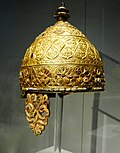Gauls
Gauls were a group of Celtic peoples and tribes inhabiting the region of Gaul, an area corresponding to what is now France, Luxembourg, Belgium, most of Switzerland, Northern Italy, as well as parts of the Netherlands and Germany on the west bank of the Rhine. The Gauls played a significant role in the history of Europe; they were known for their rich culture, art, and advanced iron-working technology. They were also famous for their conflicts with the Roman Empire, which eventually led to their conquest and cultural assimilation in the 1st century BC.
History
The history of the Gauls is complex, as it encompasses a wide range of tribes and regions over several centuries. Initially, the Gauls were divided into several tribes, each with its own territory and government. Their society was structured around the warrior aristocracy, with kings or chieftains leading the tribes. The Gauls were known for their periodic raids into Italy and conflict with the Roman Republic, which culminated in the Gallic Wars led by Julius Caesar. Caesar's conquest of Gaul extended Roman territory and marked the end of Gallic independence.
Culture
Gaulish culture was rich and varied, with a strong emphasis on craftsmanship, particularly in metalwork. The Gauls were skilled in the creation of intricate jewelry, weapons, and armor, often decorated with distinctive Celtic motifs. They practiced a polytheistic religion, with a pantheon of gods similar to those of other Celtic regions. Druids, who served as priests, teachers, and judges, played a significant role in Gaulish society, overseeing religious ceremonies and the legal system.
Language
The Gauls spoke Gaulish, a now-extinct Celtic language. Evidence of Gaulish can be found in inscriptions, coins, and occasional references in Greek and Roman literature. Despite the Roman conquest, Gaulish continued to be spoken in some areas until the 6th century AD, when it was gradually replaced by Latin, from which the French language eventually evolved.
Roman Gaul
Following their conquest, the Romans divided Gaul into several provinces, including Gallia Narbonensis, Gallia Aquitania, and Gallia Belgica. Roman rule brought significant changes to Gaulish society, including the introduction of Roman law, culture, and infrastructure. Many Gauls adopted Roman customs and language, leading to a fusion of Roman and Gaulish cultures. The Roman period also saw the spread of Christianity throughout Gaul.
Legacy
The legacy of the Gauls is evident in modern France and other parts of Europe. Place names, cultural traditions, and linguistic elements trace their origins back to the Gauls. The story of the Gauls, particularly their resistance to Roman conquest, has become a symbol of French national identity and pride.
See Also
| Ancient Rome topics | ||||||||
|---|---|---|---|---|---|---|---|---|
|
Gauls gallery
Transform your life with W8MD's budget GLP-1 injections from $125.
W8MD offers a medical weight loss program to lose weight in Philadelphia. Our physician-supervised medical weight loss provides:
- Most insurances accepted or discounted self-pay rates. We will obtain insurance prior authorizations if needed.
- Generic GLP1 weight loss injections from $125 for the starting dose.
- Also offer prescription weight loss medications including Phentermine, Qsymia, Diethylpropion, Contrave etc.
NYC weight loss doctor appointments
Start your NYC weight loss journey today at our NYC medical weight loss and Philadelphia medical weight loss clinics.
- Call 718-946-5500 to lose weight in NYC or for medical weight loss in Philadelphia 215-676-2334.
- Tags:NYC medical weight loss, Philadelphia lose weight Zepbound NYC, Budget GLP1 weight loss injections, Wegovy Philadelphia, Wegovy NYC, Philadelphia medical weight loss, Brookly weight loss and Wegovy NYC
|
WikiMD's Wellness Encyclopedia |
| Let Food Be Thy Medicine Medicine Thy Food - Hippocrates |
Medical Disclaimer: WikiMD is not a substitute for professional medical advice. The information on WikiMD is provided as an information resource only, may be incorrect, outdated or misleading, and is not to be used or relied on for any diagnostic or treatment purposes. Please consult your health care provider before making any healthcare decisions or for guidance about a specific medical condition. WikiMD expressly disclaims responsibility, and shall have no liability, for any damages, loss, injury, or liability whatsoever suffered as a result of your reliance on the information contained in this site. By visiting this site you agree to the foregoing terms and conditions, which may from time to time be changed or supplemented by WikiMD. If you do not agree to the foregoing terms and conditions, you should not enter or use this site. See full disclaimer.
Credits:Most images are courtesy of Wikimedia commons, and templates, categories Wikipedia, licensed under CC BY SA or similar.
Contributors: Prab R. Tumpati, MD








